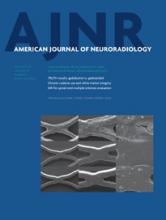Use of social media by medical professionals is increasing. Twitter (twitter.com, San Francisco, California) is the social media platform that has attracted the most attention. Recently, radiologists have used Twitter as a “virtual lounge” to engage in professional conversations on topics related to their shared interests or concerns. Twitter has been increasingly used during scientific national and international meetings as an effective means of communication. A recent study by Hawkins (@MattHawkinsMD) et al1 demonstrated the increasing trend of Twitter use during the Annual Meetings of the Radiological Society of North America. Our personal experience also showed increased and effective use of Twitter during the Annual Meeting and Chapter Leadership Conference of the American College of Radiology.
For this year's American Society of Neuroradiology (ASNR) Annual Meeting, the hashtag #ASNR14 was registered with Symplur (Upland, California), a healthcare social media analytics organization. Hashtags are words or phrases preceded with the symbol # and serve as tags for following and tracking conversations and groups of messages. Our on-the-scene experience and analysis of the aggregated data by Symplur shows that neuroradiologists have not embraced social media as fast as other radiologists. A total of 404 tweets using the “ASNR14” hashtag were logged from May 15 to May 23, 2014 (Fig 1). These tweets were posted by 51 users, including 11 radiologists attending the meeting, 12 radiologists not attending the meeting, 8 non-radiologists, and 20 institutional accounts. Of the total tweets, 56% (227 of 404) were sent by 3 users, all of whom were radiologists.
Frequency of posted tweets related to the 2014 Annual Meeting of the American Society of Neuroradiology (ASNR 2014) from May 15–23, 2014.
Twitter is a microblogging platform that logs almost 340 million tweets (small on-line posts consisting of 140 or fewer characters) each day. Such platforms are not just the domains of teenagers; corporations, politicians, the news media, and social movements have recognized the potential power of these new methods of communication and networking.2 Familiarity with such social media provides neuroradiologists with a powerful tool for communication, which can be used for professional (and personal) purposes.
Common concerns when discussing social media for healthcare are privacy and patient information confidentiality. A simple caveat must always be kept in mind: what is posted remains forever. As such, one should refrain from posting anything that could be offensive to others or embarrassing to the sender. Many platforms provide options to limit others' access to one's posts per the user's discretion. However, it is better to assume that such “firewalls” are not always functional. Another concern regarding social media is the potential infringement of one's professional life into one's personal life. Many people use their Twitter account only for professional purposes and do not post private matters. Others create more than one account and use each account for a different purpose.
The value of social media for networking is underestimated. Through the use of hashtags (searchable tags), people from around the world can find ongoing or past conversations on topics of interest. They can join these conversations by including the same hashtag in their posts, thus allowing an unlimited number of people to join the conversation, a true “Conversation Sans Frontières.” Some conversations stay on the Web for potential interested parties who may not be on-line in real time, and participants can join and engage in them at their convenience. An off-line user can be invited into conversations by inclusion of his or her Twitter ID (handle) preceded by “@.” Such networking potentials offer great value for busy neuroradiologists and can open new horizons for professional links and research collaborations. For those exploring the job market, this platform may be used for researching job opportunities.3
Twitter has been used in national and international conferences as a means of communication between individuals regarding particular sessions as well as a platform for organizers to make meeting-related announcements. Twitter allows people from around the world who are not physically present to join the conversation and be part of the “think tank.” For example, the ASNR 2014 debate session on the role of diffusion tensor imaging in traumatic brain injury prompted a stimulating and energetic Twitter conversation between individuals from around the globe, all thanks to the use of session- and meeting-related hashtags (#TBI, #ASNR14, #debate).
- © 2015 by American Journal of Neuroradiology








